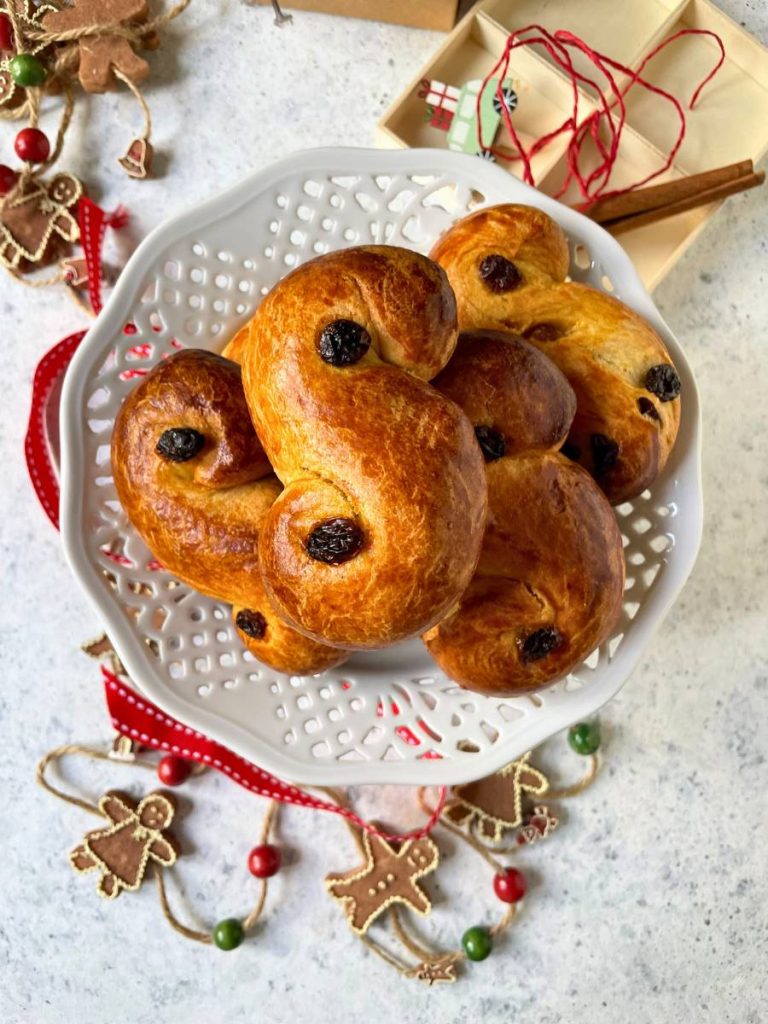The lussekatter are saffron and raisin buns traditionally served on December 13th, Saint Lucia’s Day.
They are usually shaped like an “s”, reminiscent of some Bronze Age patterns and a cat’s tail, but they can also take other forms.
Lussekatter are related to other sweets, the so-called “Jul breads” that were consumed during the pagan winter solstice celebrations.
According to the Christian interpretation, the tradition derives from a legend that spread in Germany in the 17th century, which would also explain the origin of the name lussekatt: according to this legend, the devil appeared in the form of a cat while Baby Jesus was offering buns to a good child.
In Sweden, the worship of Saint Lucia has been widespread since the 17th century, and every year on the Festival of Lights celebrated for Saint Lucia, girls serve these sweets, dressed in white gowns with delightful crowns on their heads.
Related to Scandinavia and the celebrations of Saint Lucia and Christmas, I’ve prepared some truly delicious recipes:

- Difficulty: Easy
- Cost: Economical
- Rest time: 2 Hours
- Preparation time: 15 Minutes
- Portions: 8 lussekatter
- Cooking methods: Oven
- Cuisine: Scandinavian
- Seasonality: Winter
- Energy 332.08 (Kcal)
- Carbohydrates 52.82 (g) of which sugars 18.82 (g)
- Proteins 8.27 (g)
- Fat 11.06 (g) of which saturated 6.51 (g)of which unsaturated 4.53 (g)
- Fibers 2.04 (g)
- Sodium 54.48 (mg)
Indicative values for a portion of 105 g processed in an automated way starting from the nutritional information available on the CREA* and FoodData Central** databases. It is not food and / or nutritional advice.
* CREATES Food and Nutrition Research Center: https://www.crea.gov.it/alimenti-e-nutrizione https://www.alimentinutrizione.it ** U.S. Department of Agriculture, Agricultural Research Service. FoodData Central, 2019. https://fdc.nal.usda.gov
Ingredients for lussekatter
- 3 cups all-purpose flour
- 2/3 cup milk
- 1/2 cup sugar
- 5 1/2 tbsp butter
- 1/3 cup raisins (softened in a bit of water)
- 1 1/2 tbsp fresh yeast
- 1 egg yolk
- 1/2 tsp salt
- 1 egg yolk
- 1 tbsp milk
Tools
- Stand Mixer
Preparation of lussekatter
The day before, prepare the saffron. Grind the threads with a pestle and place them in a small bowl. Add a little warm milk and let it rest.
Dissolve the yeast in lukewarm milk and melt the butter, allowing it to cool.
Sift the flour and place it in the stand mixer bowl, add the sugar, salt, saffron dissolved in milk, and activate the mixer with the paddle attachment. Gradually add the milk with the yeast, the melted cooled butter, and the egg yolk. Knead for 10 minutes, then add the raisins, reserving 16 pieces.
Cover the dough with plastic wrap and let it rest for an hour.
Take the dough and divide it into 8 parts. Roll them into ropes about 8 inches long and curl them into an S shape. Decorate with a raisin in each curl of the S. Cover with a clean towel and let rise for an hour.
Mix the remaining egg yolk with a little milk and glaze the lussekatter.
Bake in a preheated oven at 356°F for about 20 minutes.
Let cool slightly before serving.
Lussekatter can be stored for a few days in an airtight container. Heat them for a few seconds in the microwave before consuming.

